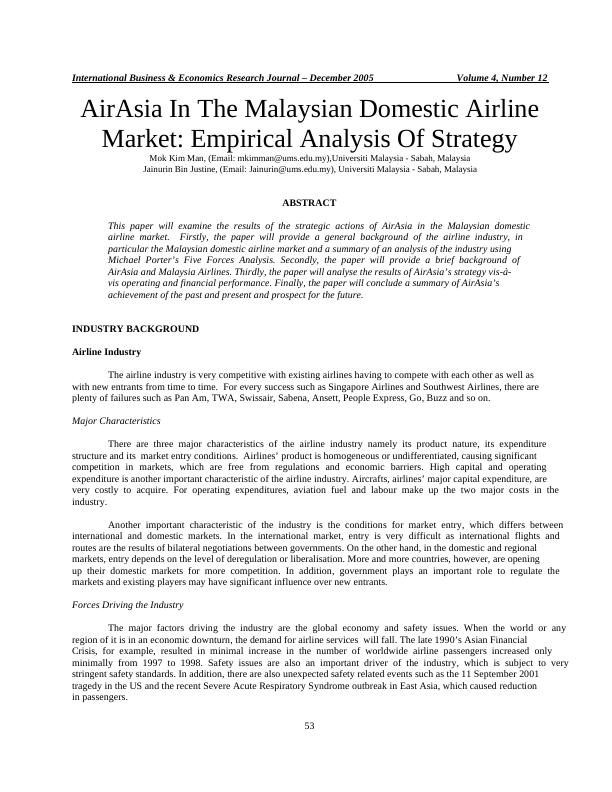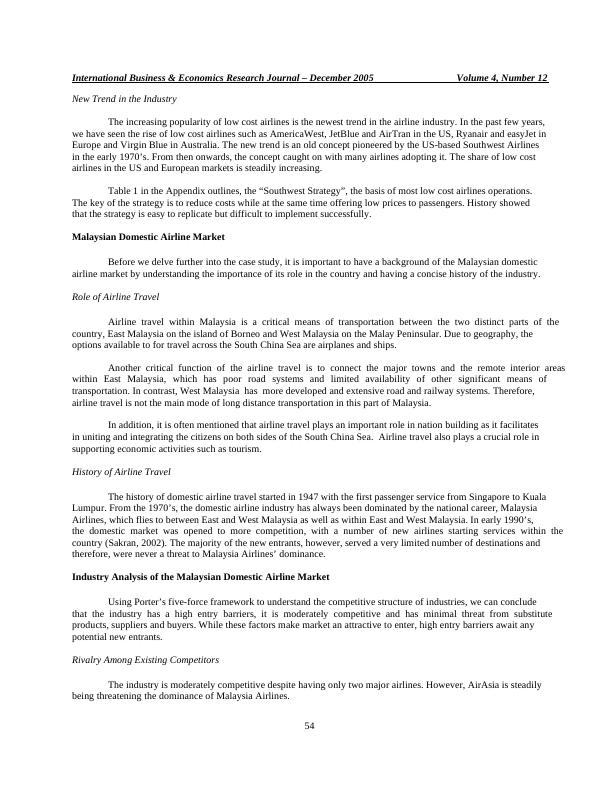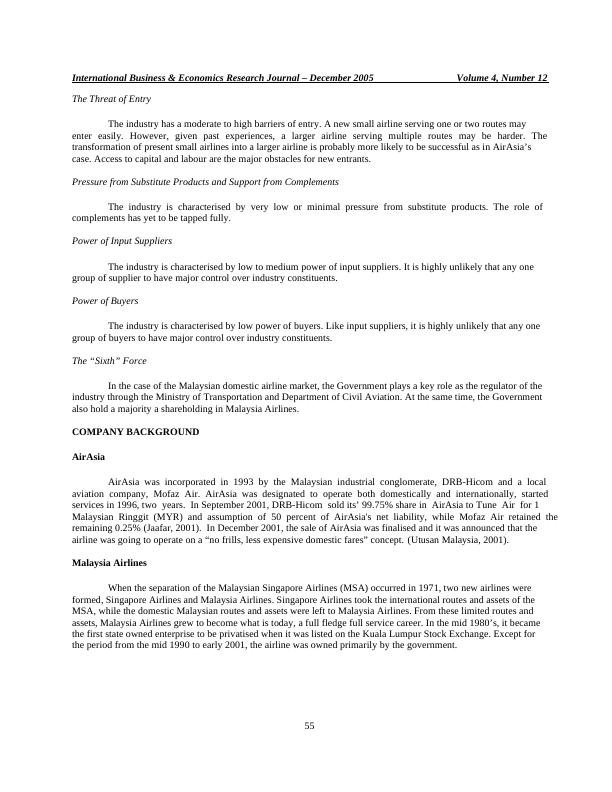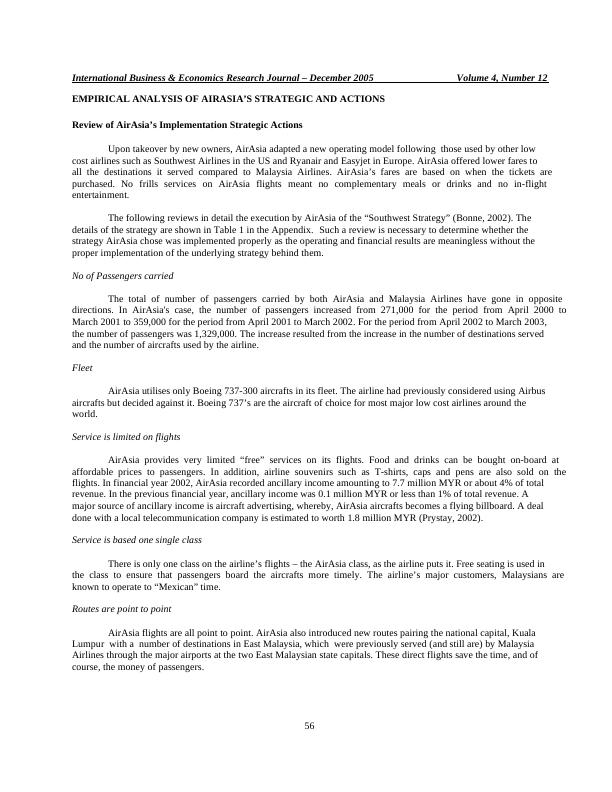Ask a question from expert
International Business & Economics Research Journal
12 Pages6450 Words95 Views
Added on 2021-07-07
International Business & Economics Research Journal
Added on 2021-07-07
BookmarkShareRelated Documents
International Business & Economics Research Journal – December 2005 Volume 4, Number 12 53 AirAsia In The Malaysian Domestic Airline Market: Empirical Analysis Of Strategy Mok Kim Man, (Email: mkimman@ums.edu.my),Universiti Malaysia - Sabah, Malaysia Jainurin Bin Justine, (Email: Jainurin@ums.edu.my), Universiti Malaysia - Sabah, Malaysia ABSTRACT This paper will examine the results of the strategic actions of AirAsia in the Malaysian domestic airline market. Firstly, the paper will provide a general background of the airline industry, in particular the Malaysian domestic airline market and a summary of an analysis of the industry using Michael Porter’s Five Forces Analysis. Secondly, the paper will provide a brief background of AirAsia and Malaysia Airlines. Thirdly, the paper will analyse the results of AirAsia’s strategy vis-à-vis operating and financial performance. Finally, the paper will conclude a summary of AirAsia’s achievement of the past and present and prospect for the future. INDUSTRY BACKGROUND Airline Industry The airline industry is very competitive with existing airlines having to compete with each other as well as with new entrants from time to time. For every success such as Singapore Airlines and Southwest Airlines, there are plenty of failures such as Pan Am, TWA, Swissair, Sabena, Ansett, People Express, Go, Buzz and so on. Major Characteristics There are three major characteristics of the airline industry namely its product nature, its expenditure structure and its market entry conditions. Airlines’ product is homogeneous or undifferentiated, causing significant competition in markets, which are free from regulations and economic barriers. High capital and operating expenditure is another important characteristic of the airline industry. Aircrafts, airlines’ major capital expenditure, are very costly to acquire. For operating expenditures, aviation fuel and labour make up the two major costs in the industry. Another important characteristic of the industry is the conditions for market entry, which differs between international and domestic markets. In the international market, entry is very difficult as international flights and routes are the results of bilateral negotiations between governments. On the other hand, in the domestic and regional markets, entry depends on the level of deregulation or liberalisation. More and more countries, however, are opening up their domestic markets for more competition. In addition, government plays an important role to regulate the markets and existing players may have significant influence over new entrants. Forces Driving the Industry The major factors driving the industry are the global economy and safety issues. When the world or any region of it is in an economic downturn, the demand for airline services will fall. The late 1990’s Asian Financial Crisis, for example, resulted in minimal increase in the number of worldwide airline passengers increased only minimally from 1997 to 1998. Safety issues are also an important driver of the industry, which is subject to very stringent safety standards. In addition, there are also unexpected safety related events such as the 11 September 2001 tragedy in the US and the recent Severe Acute Respiratory Syndrome outbreak in East Asia, which caused reduction in passengers.

International Business & Economics Research Journal – December 2005 Volume 4, Number 12 54 New Trend in the Industry The increasing popularity of low cost airlines is the newest trend in the airline industry. In the past few years, we have seen the rise of low cost airlines such as AmericaWest, JetBlue and AirTran in the US, Ryanair and easyJet in Europe and Virgin Blue in Australia. The new trend is an old concept pioneered by the US-based Southwest Airlines in the early 1970’s. From then onwards, the concept caught on with many airlines adopting it. The share of low cost airlines in the US and European markets is steadily increasing. Table 1 in the Appendix outlines, the “Southwest Strategy”, the basis of most low cost airlines operations. The key of the strategy is to reduce costs while at the same time offering low prices to passengers. History showed that the strategy is easy to replicate but difficult to implement successfully.Malaysian Domestic Airline Market Before we delve further into the case study, it is important to have a background of the Malaysian domestic airline market by understanding the importance of its role in the country and having a concise history of the industry. Role of Airline Travel Airline travel within Malaysia is a critical means of transportation between the two distinct parts of the country, East Malaysia on the island of Borneo and West Malaysia on the Malay Peninsular. Due to geography, the options available to for travel across the South China Sea are airplanes and ships. Another critical function of the airline travel is to connect the major towns and the remote interior areas within East Malaysia, which has poor road systems and limited availability of other significant means of transportation. In contrast, West Malaysia has more developed and extensive road and railway systems. Therefore, airline travel is not the main mode of long distance transportation in this part of Malaysia. In addition, it is often mentioned that airline travel plays an important role in nation building as it facilitates in uniting and integrating the citizens on both sides of the South China Sea. Airline travel also plays a crucial role in supporting economic activities such as tourism. History of Airline Travel The history of domestic airline travel started in 1947 with the first passenger service from Singapore to Kuala Lumpur. From the 1970’s, the domestic airline industry has always been dominated by the national career, Malaysia Airlines, which flies to between East and West Malaysia as well as within East and West Malaysia. In early 1990’s, the domestic market was opened to more competition, with a number of new airlines starting services within the country (Sakran, 2002). The majority of the new entrants, however, served a very limited number of destinations and therefore, were never a threat to Malaysia Airlines’ dominance. Industry Analysis of the Malaysian Domestic Airline Market Using Porter’s five-force framework to understand the competitive structure of industries, we can conclude that the industry has a high entry barriers, it is moderately competitive and has minimal threat from substitute products, suppliers and buyers. While these factors make market an attractive to enter, high entry barriers await any potential new entrants. Rivalry Among Existing Competitors The industry is moderately competitive despite having only two major airlines. However, AirAsia is steadily being threatening the dominance of Malaysia Airlines.

International Business & Economics Research Journal – December 2005 Volume 4, Number 12 55 The Threat of Entry The industry has a moderate to high barriers of entry. A new small airline serving one or two routes may enter easily. However, given past experiences, a larger airline serving multiple routes may be harder. The transformation of present small airlines into a larger airline is probably more likely to be successful as in AirAsia’s case. Access to capital and labour are the major obstacles for new entrants.Pressure from Substitute Products and Support from Complements The industry is characterised by very low or minimal pressure from substitute products. The role of complements has yet to be tapped fully. Power of Input Suppliers The industry is characterised by low to medium power of input suppliers. It is highly unlikely that any one group of supplier to have major control over industry constituents. Power of Buyers The industry is characterised by low power of buyers. Like input suppliers, it is highly unlikely that any one group of buyers to have major control over industry constituents. The “Sixth” Force In the case of the Malaysian domestic airline market, the Government plays a key role as the regulator of the industry through the Ministry of Transportation and Department of Civil Aviation. At the same time, the Government also hold a majority a shareholding in Malaysia Airlines. COMPANY BACKGROUND AirAsia AirAsia was incorporated in 1993 by the Malaysian industrial conglomerate, DRB-Hicom and a local aviation company, Mofaz Air. AirAsia was designated to operate both domestically and internationally, started services in 1996, two years. In September 2001, DRB-Hicom sold its’ 99.75% share in AirAsia to Tune Air for 1 Malaysian Ringgit (MYR) and assumption of 50 percent of AirAsia's net liability, while Mofaz Air retained the remaining 0.25% (Jaafar, 2001). In December 2001, the sale of AirAsia was finalised and it was announced that the airline was going to operate on a “no frills, less expensive domestic fares” concept.(Utusan Malaysia, 2001). Malaysia Airlines When the separation of the Malaysian Singapore Airlines (MSA) occurred in 1971, two new airlines were formed, Singapore Airlines and Malaysia Airlines. Singapore Airlines took the international routes and assets of the MSA, while the domestic Malaysian routes and assets were left to Malaysia Airlines. From these limited routes and assets, Malaysia Airlines grew to become what is today, a full fledge full service career. In the mid 1980’s, it became the first state owned enterprise to be privatised when it was listed on the Kuala Lumpur Stock Exchange. Except for the period from the mid 1990 to early 2001, the airline was owned primarily by the government.

International Business & Economics Research Journal – December 2005 Volume 4, Number 12 56 EMPIRICAL ANALYSIS OF AIRASIA’S STRATEGIC AND ACTIONS Review of AirAsia’s Implementation Strategic Actions Upon takeover by new owners, AirAsia adapted a new operating model following those used by other low cost airlines such as Southwest Airlines in the US and Ryanair and Easyjet in Europe. AirAsia offered lower fares to all the destinations it served compared to Malaysia Airlines. AirAsia’s fares are based on when the tickets are purchased. No frills services on AirAsia flights meant no complementary meals or drinks and no in-flight entertainment. The following reviews in detail the execution by AirAsia of the “Southwest Strategy” (Bonne, 2002). The details of the strategy are shown in Table 1 in the Appendix. Such a review is necessary to determine whether the strategy AirAsia chose was implemented properly as the operating and financial results are meaningless without the proper implementation of the underlying strategy behind them. No of Passengers carried The total of number of passengers carried by both AirAsia and Malaysia Airlines have gone in opposite directions. In AirAsia's case, the number of passengers increased from 271,000 for the period from April 2000 to March 2001 to 359,000 for the period from April 2001 to March 2002. For the period from April 2002 to March 2003, the number of passengers was 1,329,000. The increase resulted from the increase in the number of destinations served and the number of aircrafts used by the airline. Fleet AirAsia utilises only Boeing 737-300 aircrafts in its fleet. The airline had previously considered using Airbus aircrafts but decided against it. Boeing 737’s are the aircraft of choice for most major low cost airlines around the world. Service is limited on flights AirAsia provides very limited “free” services on its flights. Food and drinks can be bought on-board at affordable prices to passengers. In addition, airline souvenirs such as T-shirts, caps and pens are also sold on the flights. In financial year 2002, AirAsia recorded ancillary income amounting to 7.7 million MYR or about 4% of total revenue. In the previous financial year, ancillary income was 0.1 million MYR or less than 1% of total revenue. A major source of ancillary income is aircraft advertising, whereby, AirAsia aircrafts becomes a flying billboard. A deal done with a local telecommunication company is estimated to worth 1.8 million MYR (Prystay, 2002). Service is based one single class There is only one class on the airline’s flights – the AirAsia class, as the airline puts it. Free seating is used in the class to ensure that passengers board the aircrafts more timely. The airline’s major customers, Malaysians are known to operate to “Mexican” time. Routes are point to point AirAsia flights are all point to point. AirAsia also introduced new routes pairing the national capital, Kuala Lumpur with a number of destinations in East Malaysia, which were previously served (and still are) by Malaysia Airlines through the major airports at the two East Malaysian state capitals. These direct flights save the time, and of course, the money of passengers.

End of preview
Want to access all the pages? Upload your documents or become a member.
Related Documents
Management Strategy and Plan for AirAsialg...
|23
|5255
|437
South East Asian Journal of Contemporary Business, Economics and Lawlg...
|7
|6132
|102
Competitive Strategy of AirAsialg...
|25
|6069
|79
What is a Business Analysis and What does Business Analyst Dolg...
|17
|1012
|16
The performance analysis of qantaslg...
|13
|3025
|31
Easy Jet Airline Industry Reportlg...
|12
|2648
|247